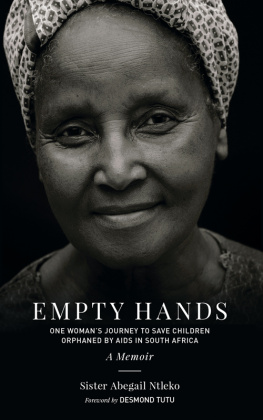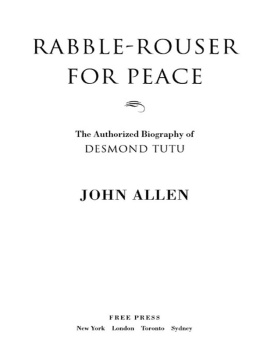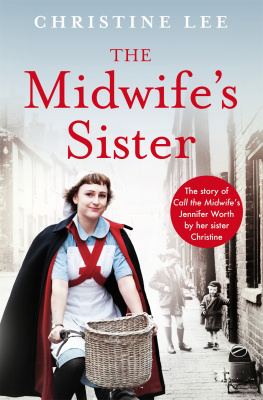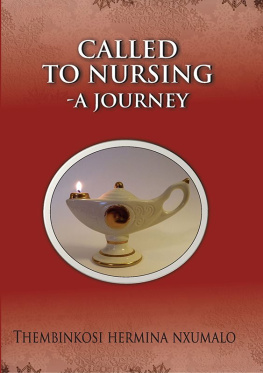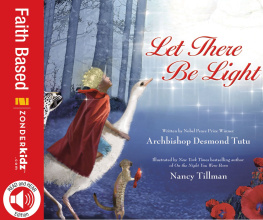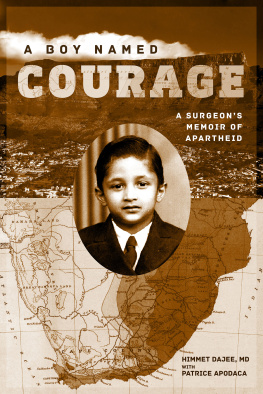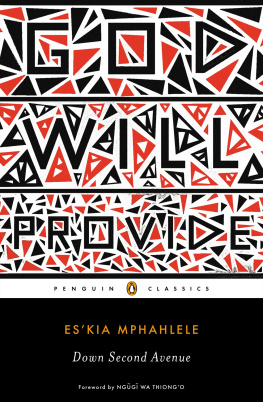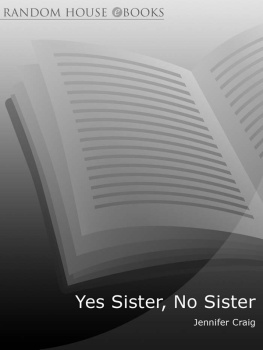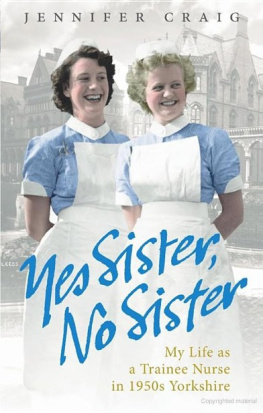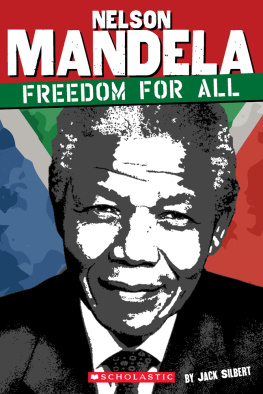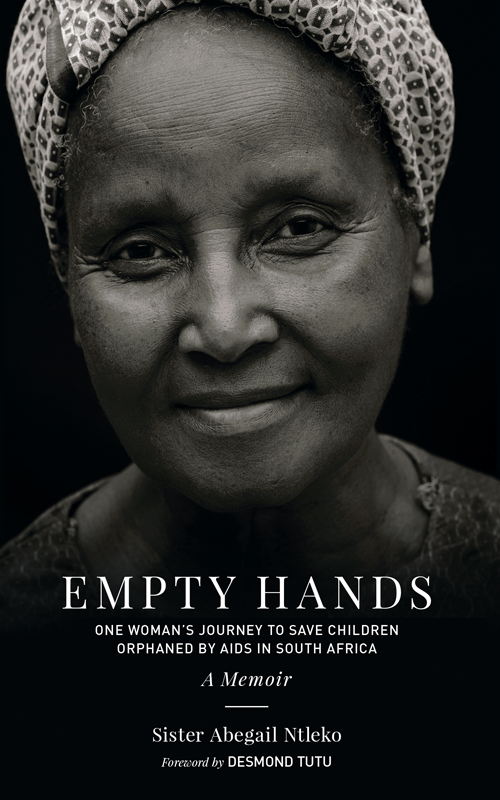EMPTY HANDS
A Memoir
ONE WOMANS JOURNEY TO SAVE CHILDREN ORPHANED BY AIDS IN SOUTH AFRICA
Sister Abegail Ntleko
Foreword by Desmond Tutu
Afterword by Kittisaro and Thanissara

North Atlantic Books
Berkeley, California
Copyright 2015 by Sister Abegail Ntleko. All rights reserved. No portion of this book, except for brief review, may be reproduced, stored in a retrieval system, or transmitted in any form or by any meanselectronic, mechanical, photocopying, recording, or otherwisewithout the written permission of the publisher. For information contact North Atlantic Books.
Published by
North Atlantic Books
Berkeley, California
Cover design by Jasmine Hromjak
Cover photo 2012 by Stefano Massei
Photos courtesy of Sister Abegail Ntleko
Photo with the Dalai Lama by Michael Yamashita
Original story written with the help of Storyzon, a California-based company whose mission is to commemorate and celebrate life stories and personal histories.
Some names and identifying details have been changed to protect the privacy of individuals.
Empty Hands, A Memoir: One Womans Journey to Save Children Orphaned by AIDS in South Africa is sponsored and published by the Society for the Study of Native Arts and Sciences (dba North Atlantic Books), an educational nonprofit based in Berkeley, California, that collaborates with partners to develop cross-cultural perspectives, nurture holistic views of art, science, the humanities, and healing, and seed personal and global transformation by publishing work on the relationship of body, spirit, and nature.
North Atlantic Books publications are available through most bookstores. For further information, visit our website at www.northatlanticbooks.com or call 800-733-3000.
Library of Congress Cataloging-in-Publication Data
Ntleko, Abegail, Sister, author.
Empty hands, a memoir : one womans journey to save children orphaned by AIDS in South Africa / Sister Abegail Ntleko ; foreword by Desmond Tutu ; afterword by Kittisaro and Thanissara.
p. ; cm.
Summary: Now 79 years old, Sister Abegail looks back over her life and recounts the remarkable events that led to her becoming the mother of dozens of children orphaned by the AIDS crisis in South AfricaProvided by publisher.
ISBN 978-1-58394-932-0 (paperback) ISBN 978-1-58394-933-7 (E-book)
I. Society for the Study of Native Arts and Sciences, sponsoring body. II. Title.
[DNLM: 1. Ntleko, Abegail, Sister. 2. Acquired Immunodeficiency SyndromehistorySouth Africa. 3. HIV InfectionshistorySouth Africa. 4. NursesSouth AfricaAutobiography. 5. AdoptionSouth Africa. 6. Child, OrphanedSouth Africa. 7. History, 20th CenturySouth Africa. 8. History, 21st CenturySouth Africa. WZ 100]
362.19697920092dc23
[B]
2015001728
In gratitude to my parents and the entire Ntleko clan, and with love to all my children
Contents
It is with great joy that I introduce the reader to Sister Abegail Ntleko and Empty Hands, a wonderful story of Abegails life and work. Sister Abegail and I share faith in the fundamental goodness of Gods deeper mystery. It is from this profound source of in-spiration that her life and work have flowed. Throughout the book we learn of the courage, wit, wisdom, and strength that Sister Abegail has brought to bear on challenges that would have undone the best of us. We also rejoice in her many victories on behalf of the vulnerable through a dedicated life of community service.
The capacity of the heart never fails to amaze me. Sister Abegail exemplifies the true heart of South Africaa heart that overcame Apartheid, that sees the best within all people, and that has never closed in the face of suffering. Her openness and her hard-earned nursing skills allowed Sister Abegail to quickly grasp the implications of the AIDS pandemic at a very early stage of its arrival into our consciousness. Since then, she has not faltered in finding ways of responding through ministering to the sick, educating her community, and establishing homes for the orphaned and vulnerable. Sister Abegails fight against AIDS has saved the lives of many and inspired even more. Her work is the vivid response of the compassionate heart.
We sometimes accomplish great things regardless of where and how we grew up, regardless of what we were told was possible. Hope can rise from the most adverse circumstances. The life and work of Sister Abegail Ntleko show that. Her story tells us what a single person can accomplish when heart and mind work together in the service of others. Hers is a remarkable tale of what it means to be fully human. It is people like Sister Abegail who usher in a better future for South Africa.
R EVEREND A RCHBISHOP D ESMOND T UTU
J ULY 2012
Twenty-four brand-new hours are before me.
I vow to live fully in each moment
and to look at all beings with eyes of compassion.
T HICH N HAT H ANH
Legs to Stand
I always loved the smell of fresh cow dung. Some families preferred mud, but we always used dung. To keep the floor of our hut tidy, we would rub in a new layer of manure every week. Id sit on my knees and spread the dung in wide circling movements and then press and rub it in until the floor became all smooth and shiny. There wouldnt be a speck of dust on it! To this day, I love that rich, earthy smell.
Our rondavel, or hut, consisted of just one round room made from mud blocks with a thatched roof. It needed constant maintenance. When a mud block would split, we had to smear in fresh mud to patch it up. When the roof started leaking, we would gather green twigs and then have somebody bend them into form and weave them onto the thatch where the hole was. All the families had to do that.
We didnt need much furniture. All we had were a couple of tree stumps for chairs, which my dad would cut according to the childrens varying heights, and a pillar post with cracks, where we would stick our spoons and knives. That was very practical because the knives could be stuck in high enough so that the smallest children couldnt reach them. In the center of the hut was the fireplace with a large cooking pot over it. Rondavels typically didnt have windows, and since the fire was going much of the time, it was always pretty smoky.
We lived outside a place called Harding in KwaZulu-Natal, South Africa, just about fifty miles from the coast. Today, Harding is a small town with a number of shops and even a golf course, but back then it was pretty rural. My mother gave birth to thirteen children. I was the twelfth. The baby who came after me died as an infant, so I was the youngest in the family.
My mothers name always makes me smile: Mancini, which means small girl. When I think of Mancini, my heart opens wide.
Shortly after giving birth to her last child, my mother died. Of course, all of us children had been born at home. I dont know if there even was a hospital, but if there was, people were too scared to go. The bleeding from that last delivery never really stopped, I was told, and my mother eventually died from anemia. I was three and a half years old.
I dont recall her face, but I am very lucky to have a photo I can remember her by. It shows a tremendously kind face with large dark eyes. It is also fortunate that she had a twin brother who looked just like her, so I could always see a bit of her in him. She was from the same area I grew up in and was one of nine children. My relatives spoke of her with great fondness. Though she wasnt educated, it seems she was a kind person, quiet and loving, ready to help wherever and whenever she could. She not only took care of her own children but also looked after other peoples, just to help out. And she worked very hard to support our family. Besides running the household, she baked and sewed and did other handwork for ladies who were getting married, and she also did the washing and ironing for a nearby farm. It couldnt have been easy for poor Mancini. She had married young, probably at age sixteen or seventeen, and by the time she passed in her early forties, seven of her children had already died. But the people she left behind remembered a woman who was dearly loved.

